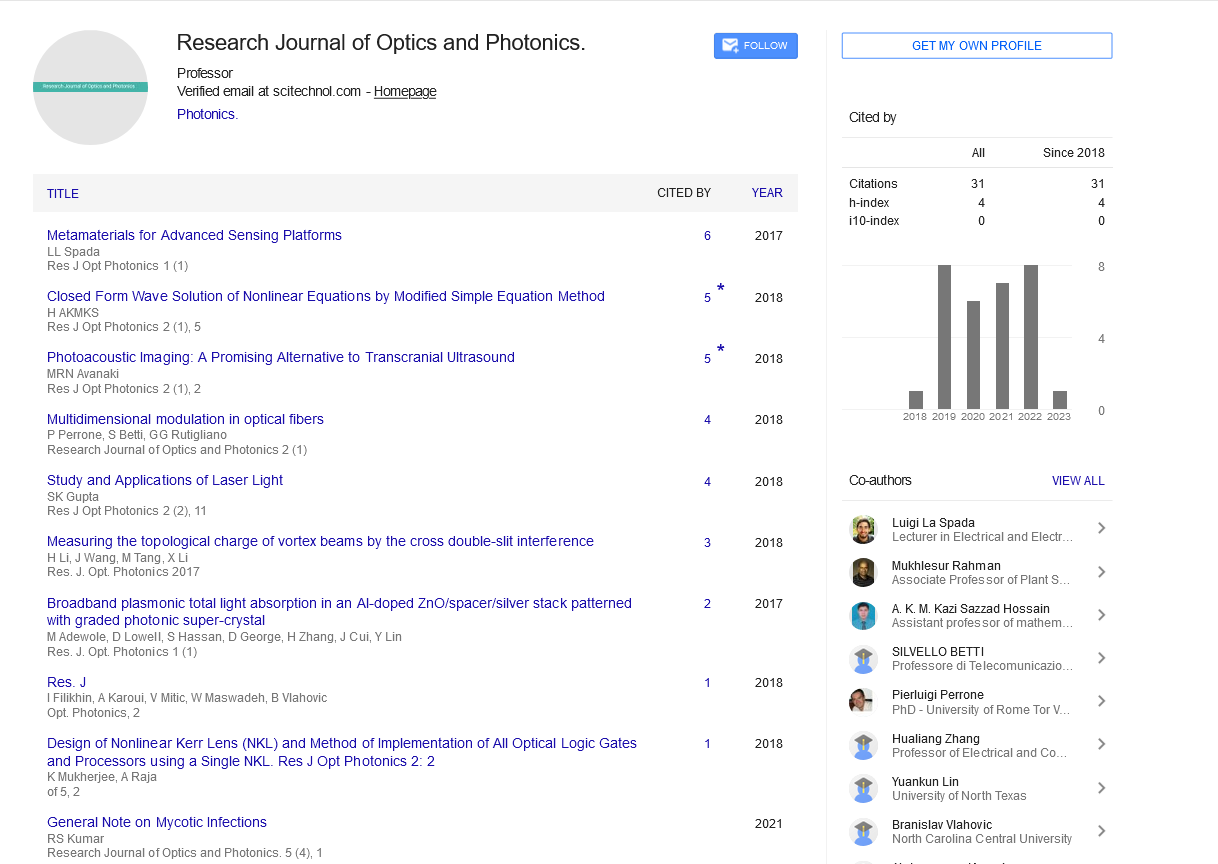Opinion Article, J Opt Photonics Vol: 7 Issue: 4
Biophotonics Role in Expanding Bioimaging Techniques
Liviu Leontie*
1Department of Physics, University of Maroua, Maroua, Cameroon
*Corresponding Author: Liviu Leontie,
Department of Physics, University of
Maroua, Maroua, Cameroon
E-mail: liviu@leon.fr
Received date: 22 November, 2023, Manuscript No. RJOP-24-128323;
Editor assigned date: 24 November, 2023, PreQC No. RJOP-24-128323 (PQ);
Reviewed date: 08 December, 2023, QC No. RJOP-24-128323;
Revised date: 15 December, 2023, Manuscript No RJOP-24-128323 (R);
Published date: 22 December, 2023, DOI: 10.4172/RJOP.23.7.1000054.
Citation: Leontie L (2023) Biophotonics Role in Expanding Bioimaging Techniques. Res J Opt Photonics 7:4.
Description
In the vast and complex area of biological research, the ability to visualize and comprehend the inner workings of living organisms is essential. While traditional imaging methods have provided invaluable insights, the limitations of visible light have often restricted our understanding. Enter biophotonics, a field that transcends these barriers by harnessing light beyond the visible spectrum, offering novel techniques and tools to illuminate the hidden world of biology. Biophotonics utilizes light across a broad range of wavelengths, extending from Ultraviolet (UV) to Infrared (IR) regions of the electromagnetic spectrum. By exploiting the unique interactions between light and biological tissues, biophotonics enables researchers to search deeper into cellular and molecular structures, resolving complexities that were once obscured by the limitations of visible light imaging. One of the primary applications of biophotonics in biological research is the development of advanced microscopy techniques that offer enhanced spatial resolution and contrast. For instance, Fluorescence Lifetime Imaging Microscopy (FLIM) uses the fluorescence decay kinetics of fluorophores to provide quantitative information about cellular environments, such as pH, ion concentrations, and protein-protein interactions. FLIM's ability to probe molecular dynamics in real-time has led to significant advancements in understanding cellular processes and disease mechanisms.
Furthermore, biophotonics has enabled the emergence of non-linear optical imaging techniques, such as two-photon microscopy and Coherent Anti-Stokes Raman Scattering (CARS) microscopy, which offer deeper tissue penetration and reduced photodamage compared to conventional methods. Two-photon microscopy utilizes two-photon excitation to induce fluorescence in biological samples, allowing for imaging at greater depths within tissues without causing significant photobleaching or phototoxicity. Similarly, CARS microscopy exploits molecular vibrational signatures to generate label-free images of biological specimens, providing valuable insights into lipid distribution, protein conformation, and cellular metabolism.
In addition to microscopy, biophotonics has facilitated the development of spectroscopic techniques that offer molecular-level information about biological samples. Raman spectroscopy, for example, probes the vibrational modes of molecules, providing chemical fingerprinting capabilities for tissue characterization and disease diagnosis. By analyzing the spectral signatures of biomolecules, such as proteins, lipids, and nucleic acids, Raman spectroscopy can differentiate between normal and diseased tissues with high accuracy, offering potential applications in cancer detection, drug screening, and tissue engineering. Moreover, biophotonics has revolutionized the field of Optical Coherence Tomography (OCT), a non-invasive imaging modality that enables high-resolution, crosssectional imaging of biological tissues. OCT's ability to visualize tissue microstructure in real-time has found widespread applications in ophthalmology, cardiology, dermatology, and gastroenterology. By providing detailed images of tissue morphology and pathology, OCT facilitates early detection, diagnosis, and monitoring of various diseases, such as age-related macular degeneration, coronary artery disease, and skin cancer.
Beyond research laboratories, biophotonics has made significant strides in clinical and biomedical applications, driving innovations in medical diagnostics, therapy, and personalized medicine. For instance, fluorescence-guided surgery utilizes fluorescent contrast agents to enhance the visualization of tumors and surgical margins during cancer resection, improving surgical outcomes and reducing the risk of tumor recurrence. Similarly, Photodynamic Therapy (PDT) employs photosensitizing agents and light activation to selectively target and destroy cancer cells, offering a minimally invasive treatment option with fewer side effects than traditional therapies. As the future holds immense promise for further advancements in biological imaging, personalized medicine, and improved healthcare outcomes.
 Spanish
Spanish  Chinese
Chinese  Russian
Russian  German
German  French
French  Japanese
Japanese  Portuguese
Portuguese  Hindi
Hindi 